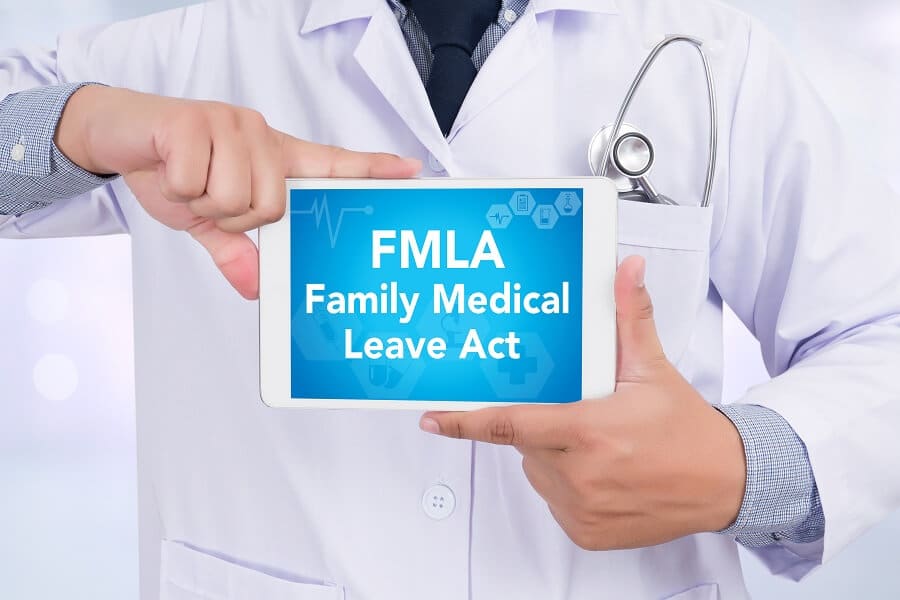Family and Medical Leave Act Overview for Business Owners & Managers

FMLA Employee Benefits
The United State’s federal Family and Medical Leave Act (FMLA) was created to provide job protection for employees under certain family or medical reasons. The act provides a way for parents to bond with a new child, take leave for family or personal medical reasons.
In addition to job protection, the act also protects employees group insurance during the leave. The act usually provides 12 weeks of protected leave to employees each year, but under the military medical provisions, employees can take up to 26 weeks of leave.
Family and Medical Leave Act Provisions for Employees
FMLA was created in 1993 to provide up to 12, and in some cases 26 weeks of unpaid protected leave to employees of large employers across the United States. To be eligible for FMLA, employers and employees must been several qualifications.
First, the employee must work at a company that has 50 or more employees within a 75 mile radius.
Secondly, the employee must have worked for the employer for at least 12 months, although it doesn’t have to be a consecutive 12 month period.
Lastly the employee must have worked at least 1,250 hour for the employer within the previous 12 months. In addition all government agencies and private and public elementary and secondary schools are included, regardless of the number of employees the agency or school employers.
- Any Government agency and any private or public elementary or secondary school
- Employers with 50 employees within a 75 mile radius
- Employees who have worked at least 12 months for the qualified employer and
- Employees who have worked at least 1,250 hours in the preceding 12 months to the leave.
Leave Reasons for FMLA
Under FMLA, employees can take leave for several reasons.
First they can take leave when the employee is unable to perform their work duties due to a serious illness or injury. They can also take leave when an allowed family member has a serious injury or illness so that they can care for their family member.
Third employees can take leave to bond with a new child, either through birth, adoption or placement via foster care into the employee’s home.
Fourth employees can take FMLA when a qualifying family member is called into active duty with the military.
Lastly, FMLA provides up to 26 weeks of leave for employees to care for a services member who has a serious injury or illness
- Bonding with a new child within first 12 months of birth, adoption or foster care placement
- Care for qualified family member who has a serious illness or injury
- Care for themselves due to a serious illness or injury.
- To care for a covered service member with a serious illness or injury if the employee is the service member’s parent, child, spouse or next of kin.
Qualified Family Members Under FMLA
FMLA leave applies to specific family members which include children, parents and spouses. FMLA acknowledges biological, adopted, foster, and step relationships. In the case of parents or children, it also acknowledges in loco parentis relationships.
In loco parentis relationships are relationships where an individual has the daily responsibility to financially support a child. Children are included in FMLA leave if the child is under the age of 18 or is over 18, but is unable to care for themselves due to a mental or physical disability. Parents include all of the previously named relationships, including individuals who stood as in loco parentis relationships to the employee when the employee was a minor. Parents do not include in-law parents.
Spouses are included if they live in a state and are legally married. With the legalization of same-sex marriage in 2015, FMLA now covers same-sex marriages as well. Next of kin is also an allowed family relationship when a military member has a serious injury or illness and has none of the other specified family relationships.
- Parents
- Children under 18, unless the child is incapable of self-care
- Spouses, including same sex spouses
It is important to understand that on the Department of Labor’s (DOL) website, in loco parentis is shown to include children who are without a biological or legal parental relationship. Some of the examples of in loco parentis relationships include grandparents who care for a grandchild or aunts or uncles who care for a child whose parents have died.
Another relationship that is provided by the DOL is a child of a domestic partner for whom the employee has assumed an in loco parentis relationship with.
Employees asserting an in loco parentis relationship must provide a statement with the child’s name and a statement of the employees in loco parentis’ relationship with the child.
Serious Health Condition under FMLA
Under FMLA law, a serious health condition is an injury or illness that contains one of several characteristics. Serious health conditions make the individual unable to perform their essential job functions.
- Any period that involves in care treatment, including at a hospital, hospice, or residential care facility
- A period of at least 3 or more days requiring absence from work, school, or other regular activities and also requires the continuing care of a health care physician.
- Any period of incapacity involving pregnancy or for prenatal care
- Any period of incapacity due to a chronic health condition including conditions such as asthma, diabetes, epilepsy or other conditions.
- Permanent or long-term conditions for which treatment may not be effective such as alzheimer’s, stroke, terminal diseases
- Any absences to receive multiple treatments or to recover from the treatments for conditions that would result in more than 3 days absences if the condition was left untreated. This includes chemotherapy, physical therapy, dialysis and other types of treatments.
In cases of these illnesses or injuries, employees can take of protected time of work when ill or sick. FMLA doesn’t cover minor sickness such as cold and the flue unless it becomes severe enough to warrant 3 days or more off of work.
Employee Notice of Leave
Employees are required by FMLA to provide a 30 notice before taking FMLA. If an employee delays notifying their employer, the employer can deny leave until after the 30 day notice was taken or for as long as the employee has delayed providing notice.
If the leave is unforeseeable, then the employee must provide notice as soon as possible. This includes emergency situations where the employee cannot immediately notify the employer, but must notify the employer as soon as it is reasonable to notify them.
Spouses who work for the Same Employer
Generally speaking, when spouses work for the same employer, the 12 weeks of leave per year is split between the spouses. It does not have to be split evening, that is, each spouse is not limited to 6 weeks. Rather, it can be divided in any split between both spouses.
However, many business owners don’t realize that there are certain situations in which spouses do not need to split the 12 weeks. Those reasons include for personal serious illness, a spouse or child’s serious illness or injury, or any qualifying contingency arising out of an employee’s child, parent, or spouse is a covered service member.
- An employee’s own serious health condition
- To care for a child or spouse with a serious health condition.
- For any exigency from a covered service member who is a child, spouse or parent. (Provides 12 weeks to each spouse)
Employers must understand how and when to split between shared FMLA and non-shared FMLA leave. For example if a husband takes leave to care for his parent for 7 weeks, then his wife can also take another 5 weeks to care for her parent. However, if instead of a parent, their child is seriously injured, then his wife can take a full 12 weeks to care for their child. The husband has already used 5 weeks, but would also be able to take another 7 weeks to care for their child.
In another example, a wife uses 4 weeks to bond with a new baby. That would leave her husband another 8 weeks to bond with their child. However, if the wife is seriously ill, then the husband would not share leave with his wife and could instead use the full 12 weeks to care for his wife. In addition, the wife would also have another 8 weeks for her own serious illness.
These examples demonstrate the importance of employers understanding when and how to split FMLA leave. Employers who assume that all FMLA leave should be split between spouses will be out of compliance and run the risk of fines and penalties by the DOL.
Covered Exigency under FMLA
Employees can take a full 12 weeks of FMLA when a child, spouse or parent is on active military duty or called into active duty to a foreign country. The time provided under FMLA is not split between spouses working for the same employer. Covered exigencies include issues arising from short notice deployment, attending military events and related activities, and childcare and other related activities.
- Issues from short notice deployment: less than 7 days notice
- Attending military events and related activities: official ceremonies, programs, events, informational briefings, or family support or assistance programs
- Childcare and related activities: arranging for alternative care, providing childcare on a non-routine, urgent, immediate basis, or enrolling or transferring a child to a new school or day care facility.
- Making or updating financial and legal arrangements; preparing financial and legal documents, enrolling in Defense Enrollment Eligibility Reporting System, or obtaining military IDs.
- Attending counseling
- Up to 15 days during active military members short term rest and recuperation to spend time with the covered military member
- Post deployment activities for up to 90 days; attending arrival ceremonies, reintegration briefings and events, addressing issues due to a death of a military member
- Any other event that the employee and employer agree is an exigency under FMLA
Let SwipeClock Help
Businesses are finding themselves accountable to Federal employment laws, state labor laws, and local city ordinances. Often businesses have to comply with secure scheduling, sick leave, or local family leave laws.
Additionally, the Federal Family Medical leave, Affordable Care and and other laws can become confusing for employers to comply with. This becomes increasingly difficult and time consuming for Human Resource departments and Payroll personnel to track.
The cost of non-compliance costs businesses billions in fines and remedies every year.
SwipeClock provides a comprehensive array of workforce management and time tracking tools that can help businesses to more easily stay in compliance with local and national laws.
Records are effortlessly kept for years and accrual is automatically tracked and reported to employees according to the state and city laws. Additionally, with geo-timekeeping clocks, businesses can effortlessly track time worked in specific cities to ensure compliance.
Resources
DOL FMLA Compliance
Written by Annemaria Duran. Last updated July 3, 2017
Simplify HR management today.
Simplify HR management today.
Everything You Need to Know About the Corporate Transparency Act (And How It Impacts Your Business)
Staying current on legislation that may impact your business or impose new regulations is vital to remaining in compliance and avoiding costly fines. One piece of legislation that affects nearly all businesses under $5 million in gross revenue is the Corporate Transparency Act. If your business gross revenue comes in under that threshold and you…
Read MoreYour Guide to GPS Time Tracking (Geofencing)
Updated March 19, 2024 When your business has employees working remotely or at various job sites, time tracking can become a challenge, particularly if the company relies on physical clocks for punching in and out. But offering a mobile app or web-based tracking solution can cause some concerns. You might wonder whether employees are clocking…
Read More




